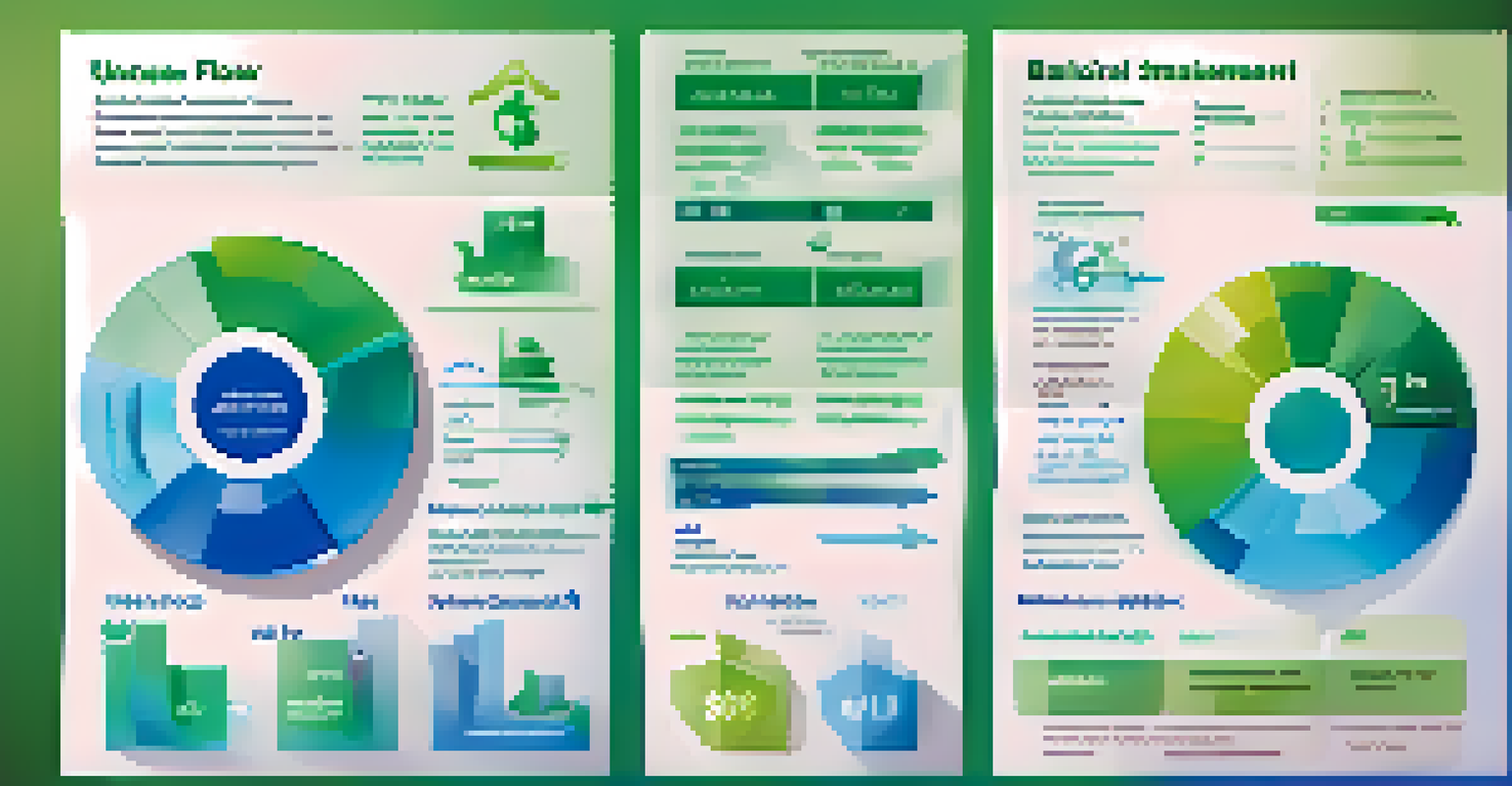Financial Statement Analysis for Small Business Investors

Understanding Financial Statements: The Basics
Financial statements are the backbone of any business's financial health. They provide crucial insights into a company's performance and profitability. For small business investors, understanding these documents is essential for making informed investment decisions.
In investing, what is comfortable is rarely profitable.
Typically, you’ll encounter three main types of financial statements: the balance sheet, income statement, and cash flow statement. Each serves a distinct purpose but collectively they tell a comprehensive story of the business's financial situation. By grasping the basics, investors can identify trends and potential red flags.
For instance, the balance sheet gives a snapshot of assets, liabilities, and equity at a specific point in time. The income statement outlines revenue and expenses over a period, while the cash flow statement tracks how cash moves in and out of the business. Together, they form a complete picture that investors can analyze.
The Balance Sheet: What It Reveals
The balance sheet is like a financial snapshot, revealing what a business owns and owes at a specific moment. It helps investors assess a company's financial stability and liquidity. By examining this statement, you can determine if the company has enough assets to cover its liabilities.

Key components to look for include current assets, current liabilities, long-term debt, and shareholders' equity. A strong balance sheet typically shows that assets exceed liabilities, indicating a healthy financial position. Conversely, if liabilities are greater, it may signal potential financial distress.
Key Financial Statements Explained
Understanding the balance sheet, income statement, and cash flow statement is essential for investors to assess a company's financial health.
For example, if a small business has a high ratio of current assets to current liabilities, it suggests good short-term financial health. Investors can use this information to gauge whether the company can meet its obligations, which is crucial for evaluating long-term viability.
Income Statement: Analyzing Profitability
The income statement is where you can find out whether a business is making money or running at a loss. It summarizes revenues, costs, and expenses over a specific period, highlighting the company's profitability. For investors, understanding this statement is crucial for evaluating operational efficiency.
The stock market is filled with individuals who know the price of everything, but the value of nothing.
Key metrics to focus on include gross profit margin, operating income, and net profit margin. These figures provide insights into how well the business converts sales into profits and how much is left after all expenses are accounted for. A consistently growing net profit margin can be a positive sign for potential investors.
Consider a small bakery that shows increasing revenue year over year but also rising costs. An investor would need to analyze whether the profit margin is still healthy or if the business is losing control over its expenses. This analysis helps in making informed decisions about investing in that bakery.
Cash Flow Statement: Understanding Cash Management
The cash flow statement is often considered the most critical financial statement because cash is king in business. It tracks the inflow and outflow of cash, giving investors insights into how well a company manages its cash resources. A strong cash flow is essential for daily operations and long-term growth.
This statement is divided into three sections: operating, investing, and financing activities. Each section provides insights into how cash is generated and spent. For instance, a positive cash flow from operating activities indicates that the business is generating enough cash to fund its operations without relying on external financing.
Identifying Financial Red Flags
Recognizing warning signs in financial statements, such as declining revenues or negative cash flow, can help investors avoid potential losses.
Imagine a tech startup that shows impressive sales growth but has negative cash flow due to heavy investment in equipment. While growth is encouraging, negative cash flow could signal potential trouble ahead. Investors must analyze cash flow to gauge the sustainability of the business model.
Key Financial Ratios Every Investor Should Know
Financial ratios are invaluable tools for investors as they provide quick insights into a company's performance. Ratios like the current ratio, debt-to-equity ratio, and return on equity can reveal much about a business's operational efficiency and financial health. Understanding these ratios can help investors make side-by-side comparisons.
For example, the current ratio, which compares current assets to current liabilities, helps assess liquidity. A ratio above 1 indicates that the company can cover its short-term obligations. On the other hand, a high debt-to-equity ratio could signal that a business relies heavily on debt to finance its growth, which can be risky.
Using these ratios in combination can provide a clearer picture of a company's overall performance. They act as indicators that guide investors in identifying which companies are worth their time and money.
Common Red Flags in Financial Statements
As an investor, it’s crucial to know what red flags to look for when analyzing financial statements. Warning signs like declining revenues, increasing debts, or negative cash flow can indicate deeper issues within a company. Recognizing these red flags early can save investors from potential losses.
For instance, if a company consistently reports higher profits but struggles with cash flow, it might be a sign of accounting irregularities or inventory issues. Similarly, if a business's expenses are rising faster than its revenue, it suggests that management may not be controlling costs effectively.
Context Matters in Analysis
Placing financial data within the context of industry benchmarks and market trends provides deeper insights into a company's performance.
By being vigilant and looking for these warning signs, investors can make more informed decisions and avoid pitfalls. It’s all about being proactive and conducting thorough due diligence before committing to any investment.
The Importance of Context in Financial Analysis
While financial statements provide valuable data, context is essential for accurate analysis. Comparing a company's financial performance to industry benchmarks or historical performance offers deeper insights. This context helps investors understand whether a company's numbers are good or bad.
For example, a small manufacturing firm might show declining sales, but if the entire industry is experiencing similar challenges, the issue may lie outside the company's control. Conversely, if a company is outperforming its peers, it could indicate a strong competitive advantage.

Thus, contextualizing financial data is crucial. Investors should always look at the bigger picture and consider external factors, market trends, and economic conditions that might influence a company's performance.
Making Informed Investment Decisions
Ultimately, financial statement analysis equips small business investors with the tools they need to make informed decisions. By understanding the nuances of balance sheets, income statements, and cash flow statements, investors can identify potential opportunities and risks. This knowledge fosters confidence in their investment choices.
Investors should also stay updated on market trends and industry developments, as these factors can impact financial performance. Regularly reviewing financial statements can reveal changes in a company's health over time, allowing investors to adjust their strategies accordingly.
In summary, mastering financial statement analysis is not just about crunching numbers; it's about telling a story. By piecing together the financial puzzle, small business investors can better navigate their investment journeys and achieve their financial goals.